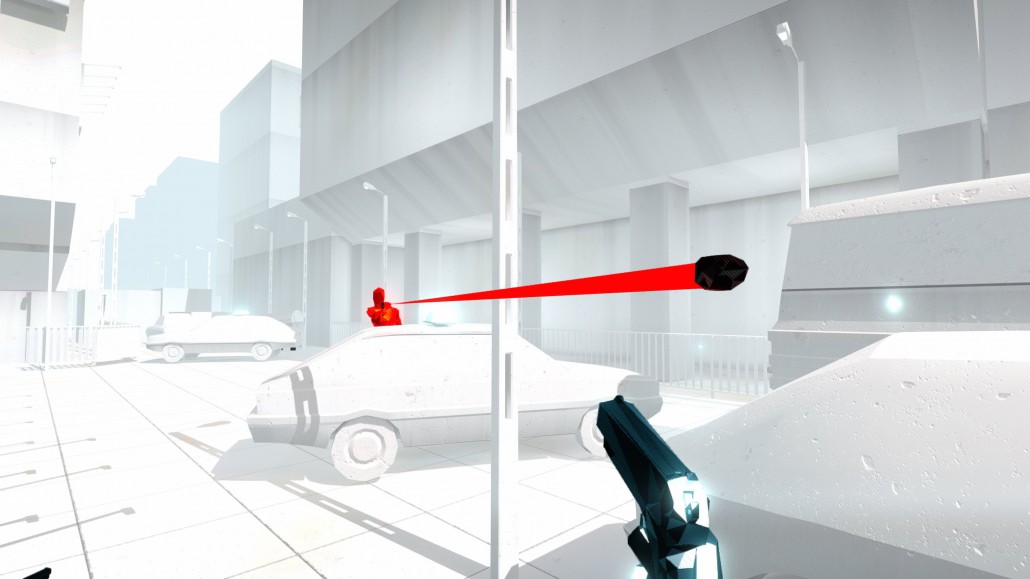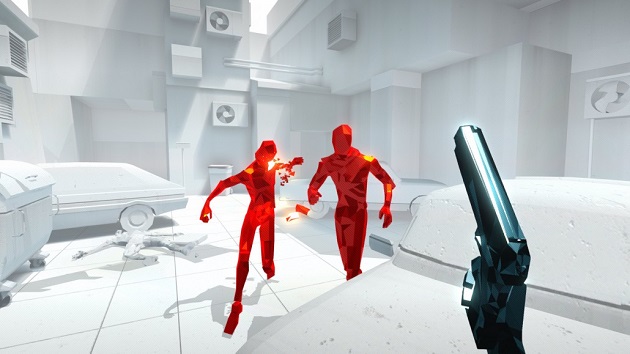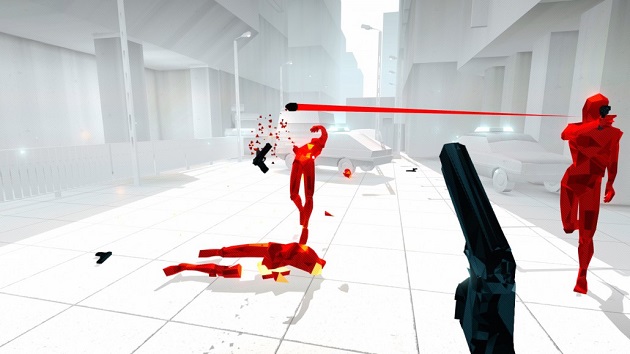An absolute necessity to carefully consider every inch of movement and proceed in slow motion isn’t what you’d expect from a game called Superhot. But that is nevertheless what you’ll get when the appropriately named Superhot Team releases its first title later this year.
Featureless red polygonal men are constantly coming for you in Superhot. If they can get close enough to punch you or to line up and make a shot just once, you’re done for. Of course, bad guys are perpetually trying to kill you in nearly all first-person shooters. The hook here is that the bad guys move in extreme slow motion when you’re not moving. You will stress over this, and you will get yourself killed if you don’t slow down and think before you move. But that didn’t stop me from continually wanting to try again during my time with the E3 demo last week.
Watching someone else play Superhot can give off the impression that no one moves at all in the game until you do, but that’s not entirely accurate. Start playing and you’ll soon figure out that, as mentioned, enemies are always moving, but their pace is glacial unless you’re also moving. The combination of their overwhelming odds and one-hit kill ability means death finds you swiftly if your every move hasn’t been meticulously planned. That means not just your shots, not just your aiming, but literally every bit of movement you make. Want to move to the left a tiny bit to get a better view of what’s around the corner? Go ahead, but know that the gun-wielding bad guy who happens to be there is then likely to gain the precious few steps forward he needs to put you in immediate danger. Even if he doesn’t kill you he’ll at least move close enough to force you to focus all attention on him, and that may lead to the guy coming from behind your back getting the few steps he needs to get the drop on you. Like a set of dominoes, attempting to stop these sort of events once set in motion is a hopeless endeavor.
Take an E3 demo level set in a bar, for example. I started in front of the bar with only seconds of movement time to dispatch the bartender before he did me in. When you begin a new Superhot level, at least in the demo, you find yourself sans weapons. Players can use a stun attack to temporarily incapacitate and enemy if he’s close enough, but the presence of the bar put the mixologist out of the stun attack’s range. So I picked a glass up off the bar and chucked it at my foe. Down he went, conveniently tossing his gun up for grabs as he did. After snatching it and shooting him dead, I noticed there was a set of doors on either side of me and moved toward those on the right. Big mistake.
Putting down the first man who burst through those doors was easy enough — but it also allowed the one coming through the left doors time to gun me down. Of course, it would have been impossible to know who was going to come from where and when. Impossible, that is, without trial and error, which is something players will frequently have to put themselves through to figure out enemy patterns and how best to respond to them before it’s too late. After dispatching the bartender same as before on my second attempt, I beelined it for the left door, killed the bloodthirsty individual who greeted me and hurried through the doorway. From there it was possible to remain motionless while looking through an open door’s small window to watch the enemies on the right side moving frame by frame. Then it was time to act.
Slowly inching forward and lining up shots in between stopping to glance back left at anyone trying to sneak up on me seemed a decent strategy. Indeed, four or five deaths later, I put string every action together just right and beat the level using those tactics. Knowing what’s coming next, dealing with the most immediate threat and intermittently stopping to check your surroundings and formulating a plan is perhaps a good approach for most games. But it’s especially so when faced with bad guys who are stuck in “bullet time” when you’re not moving. How players process and respond to the visual information will surely vary, though, so it’s likely different players will develop different methods of progressing through each level.
Skilled FPS players will undoubtedly be tempted to line up headshots. That was my first instinct, too, but taking that extra couple seconds to aim at an enemy’s head instead of his body is rarely time well spent in Superhot. This is doubly true when you factor in that, since the bad guys are always running, you must always aim not where these targets are, but where they will be. The most skilled players will no doubt master this, but going for body shots is the far quicker and safer approach.
Limited ammunition and long reload times further complicate things. Being out of ammo, however, doesn’t always mean being out of luck. Throwing your gun when you’re out of bullets to fire or out of time to reload will stun enemies, sending their guns flying into the air to be grabbed by whoever gets there first: the player or the closest unarmed enemy. It sounds paradoxical, but this means you have to move fast and slow: keep stopping to bring things to a crawl and scope your surroundings, but run like the wind when you do move to be first to the gun.
The final level I played was harrowing. Bad guys approached from three different entry points and delivered killing blows at least seven or eight times. After numerous attempts, it finally felt like I had them figured out, and I took down what seemed like the last of them. But nothing happened. The level did not end, and I anxiously spun every which way but saw no one. Only a few seconds passed, but it felt like an eternity in Superhot time. Finally, right before the game spawned more enemies, the screen was filled with these terrifying words: “They just keep coming.”
Superhot Team, at least in this one level, knows exactly when and how to toy with player expectations. Unfortunately for the red-hued killers of the world, I’ll also just keep coming if the rest of Superhot is as tense as its E3 demo.





